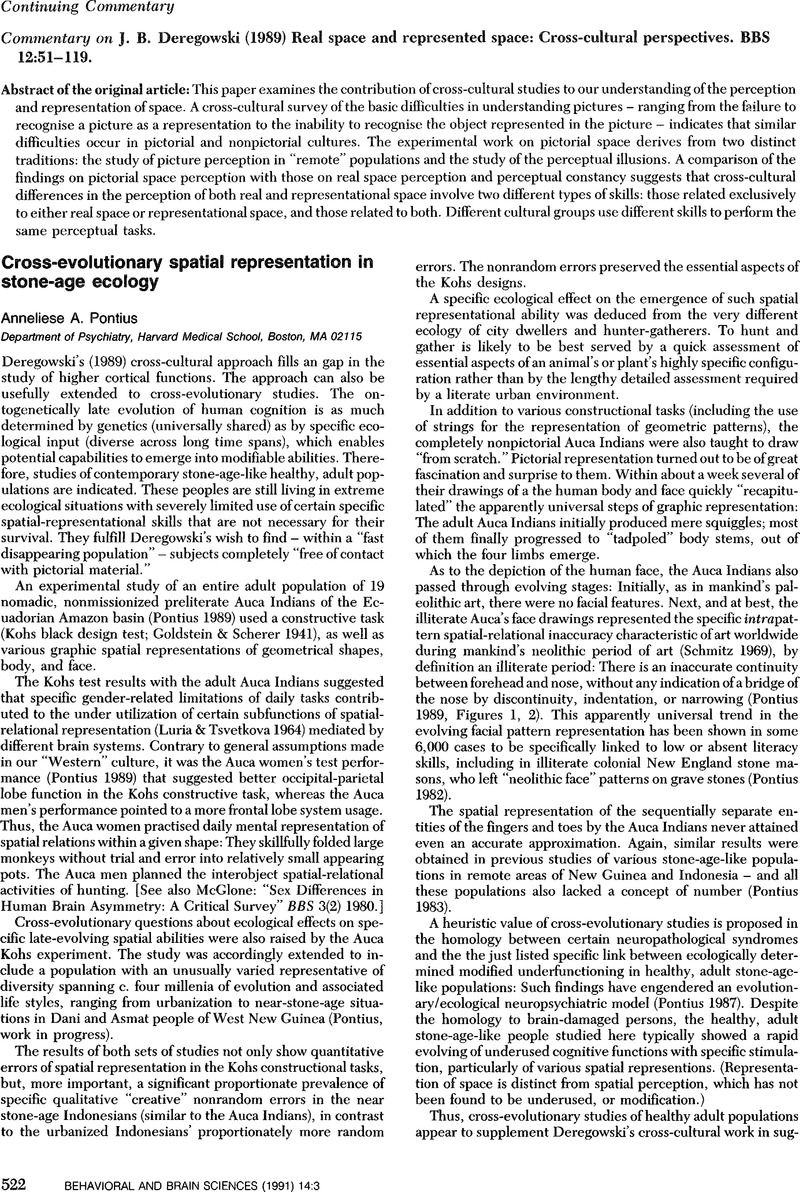No CrossRef data available.
Article contents
“Stone-age” data: Wider implications and greater difficulties
Review products
Commentary onDeregowskiJ. B. (1989) Real space and represented space: Cross-cultural perspectives. BBS 12: 51–119.
Published online by Cambridge University Press: 19 May 2011
Abstract
An abstract is not available for this content so a preview has been provided. Please use the Get access link above for information on how to access this content.

Information
- Type
- Author's Response
- Information
- Copyright
- Copyright © Cambridge University Press 1991
References
Deregowski, J. B. (1978) On re-examining Fortes' data: Some implications of drawings made by children who have never drawn before. Perception 7:479–84. [rJBD]CrossRefGoogle Scholar
Fortes, M. (1981) Tallensi children's drawings. In: Universals of human thought, ed. Lloyd, B. & Gay, J.. Cambridge University Press. [rJBD]Google Scholar
Goldstein, K. & Scheerer, M. (1941) Abstract and concrete behavior. An experimental study with special tests. Psychological Monographs 53(Whole No. 239):1–151. [AAP]CrossRefGoogle Scholar
Halverson, J. (1987) Art for art's sake in the palaeolithic. Current Anthropology 28:63–89. [rJBD]CrossRefGoogle Scholar
Lewis-Williams, J. D. (1981) Believing and seeing: Symbolic meanings in Southern San rock paintings. Academic Press. [rJBD]Google Scholar
Lewis-Williams, J. D. & Dowson, T. A. (1988) The signs of all times: Entopic phenomenon in Upper Palaeolithic art. Current Anthropology 29:201–45. [rJBD]CrossRefGoogle Scholar
Luria, A. R. & Tsvetkova, L. S. (1964) The programming of constructive activity in local brain injury. Neuropsychologia 2:95–107. [AAP]CrossRefGoogle Scholar
Marshack, A. (1989) Methodology in the analysis and interpretation of upper palaeolithic image: Theory versus contextual analysis. Rock Art Research 6:17–53. [rJBD]Google Scholar
Noble, W. & Davidson, I. (1989) On depiction and language. Current Anthropology 30:337–42. [rJBD]Google Scholar
Parker, D. M. & Deregowski, J. B. (1990) Perception and artistic style. North Holland. [rJBD]Google Scholar
Pontius, A. A. (1982) Face representation linked with literary level in colonial American tombstone engravings are Third World preliterates' drawings. Toward cultural-evolutionary neurology. Experientia 38:577–81. [rJBD, AAP]CrossRefGoogle Scholar
Pontius, A. A. (1983) Finger misrepresentation and dyscalculia in an ecological context: Toward an ecological (cultural) evolutionary neuro-psychiatry. Perceptual and Motor Skills 57:1191–1208. [rJBD, AAP]CrossRefGoogle Scholar
Pontius, A. A. (1987) Model of evolutionary ecological neuropsychiatry. Annals New York Academy of Sciences 504:309–12. [rJBD, AAP]CrossRefGoogle Scholar
Pontius, A. A. (1989) Colour and spatial error in block design in stone-age Auca Indians: Ecological underuse of occipital-parietal system in men and of frontal lobes in women. Brain and Cognition 10:54–75. [rJBD, AAP]CrossRefGoogle ScholarPubMed
Serpell, R. (1979) How specific are perceptual skills? A cross-cultural study of pattern recognition. British Journal of Psychology 70:365–80. [rJBD]CrossRefGoogle Scholar
Serpell, R. & Deregowski, J. B. (1980) The skill of pictorial perception: An interpretation of cross-cultural evidence. International Journal of Psychology 15:145–80. [rJBD]CrossRefGoogle Scholar
Shapiro, M. B. (1960) The rotation of drawings by illiterate Africans. Journal of Social Psychology 52:17–30. [rJBD]CrossRefGoogle Scholar
Ucko, P. J., ed. (1977) Form in indigenous art. Australia Institute of Aboriginal Studies. [rJBD]Google Scholar

